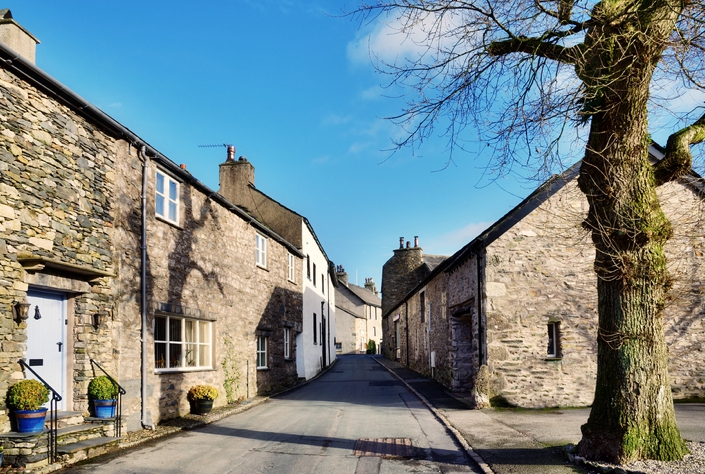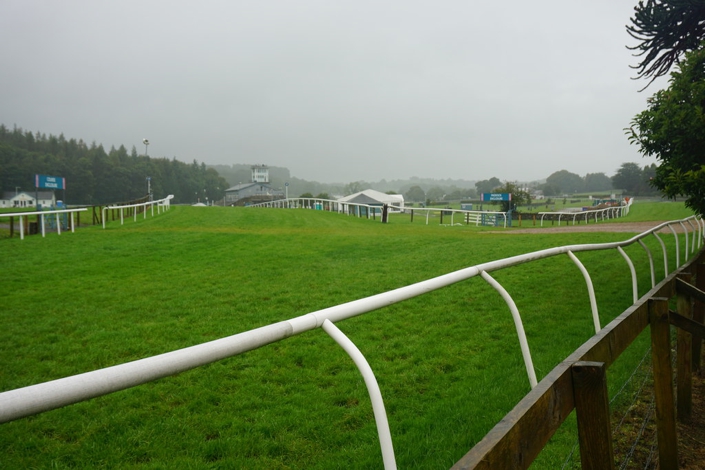Cartmel Racecourse

Set in the humble ambience of the Lake District in the county of Cumbria, Cartmel racecourse is arguably the most picturesque and aesthetically pleasing racing environment in the UK. An exclusively National Hunt track, Cartmel gets the third highest attendance of any UK jumps track after Aintree and Cheltenham, averaging a gate of 20,000 when at full capacity. The earliest recorded racing there occurred during 1856, but there is thought to have been action there for many years prior.
It has generally always been a small course, which featured predominantly amateur riders, however after WWII the racing programme was expanded and made more professional and progress continues to this day. Easily the most popular horse at Cartmel over recent years has been Soul Magic, who prior to the 2014 season had won at the track on a total of seven occasions.
There is a small grandstand on site at Cartmel, but the majority of the facilities in place are temporary. The site at Cartmel is located just 20 minutes off the M6, where leaving at Junction 36 brings those driving to sign posted directions provided by the AA. Alternatively, regular trains run to either Cark-in-Cartmel or Grange-over-sands stations, both of which are just two miles from the track and provide regular bus services.
Ticket Prices
Tickets are priced moderately generously for entry to the track, with access to the course just £12 whilst entry to the paddock is slightly more at £20. Over-60s get a £2 discount on the adult price, whilst there is a further £2 deduction for all tickets purchased online. Tickets cost slightly more for Bank Holidays and Saturdays and under-16s are allowed free entry with a full paying adult.
The Course

Unlike many other National Hunt venues, Cartmel’s figure eight circuit only hosts racing during the spring and summer months. Conditions are rarely testing as a result and this is something that tends to result in races being run very quickly here. Jockeys need to be alert from the off and ensure their horse is on the bridle because if not they will find it is a long way to the line.
The obstacles here are on the easier side and there are only six fences to a circuit but still the causality rate is quite high. In part because it is not a destination for elite chasers and in part it is due to the positioning of three fences in quick succession prior to the final bend. Fields begin to quicken at this point in races and the increased pace mean it is much easier for horses to mistime their jumps or to hit the fences too flat.
If able to successfully deal with this final trio of fences, horses face an extremely lengthy, near half a mile run-in to the winning post. Underestimating just how long there is to go after the final jump, many horses begin to tire as they close in on the winning post. The lead has a tendency of changing quite a lot during the final few furlongs as a result so never give up hope of your horse pulling it out of the bag. For previous winners, watch out for them during return visits as course form counts for plenty here.
Small and Nippy Required
There is not another National Hunt course you can compare to Cartmel which offers a distinctly unique test, not just due to the distracting smell of barbeques cooking nearby. You could argue Chester is its flat racing equivalent though as it too is a tight course in which runners are almost always on the turn.
Horses that prefer a long gallop tend to fare poorly here as a result when compared to their smaller, more agile rivals. Being able to travel is key trait too as horses tend to set off at quite a pace at Cartmel and those off the bridle can find themselves left behind in no time.
Course Specialists Not Uncommon
We touched on this earlier but it is important to emphasise how much Cartmel is a course specialist racecourse. The majority may find it hard to deal with its tightness and turns but there is a minority of runners that thrive on the challenge provided. Both Wells De Lune and Better Times Ahead I won five of their six starts on the Cumbria course while Deb’s Ball managed five from seven. Flahive’s First didn’t finish with such a sky high strike rate, instead offering a still impressive 43% win ratio but he only won three races outside of Cartmel in 117 attempts.
Major Meetings at Cartmel

Cartmel hosts a three-day meeting every May, which is actually a festival spread out over five days, with action on the first, third and last. Race goers are treated to a day off in between each day of racing in order to experience the beautiful surroundings of the Lake District, which gives the organisers an opportunity to clean up the course and prepare for the next day, as it just isn’t possible to have consecutive race days due to the early arrivals and late finishing time of the course.
There is also a two-day event every July (with a day off in between) which is reasonably new and features Cartmel’s most valuable race – The Cumbria Crystal Hurdle race – with a prize purse of over £25,000. The meeting in August features Cartmel’s two other prestigious races – the Cartmel Cup is a hurdles race, whilst the Cavendish Cup is a steeplechase.
Dining and Hospitality

Dining at Cartmel can be experienced in either of their two restaurants – The Conservatory Rest starts at £80 + VAT per person, whilst the Louis Roederer Restaurant is a bit more pricey at £115 + VAT per person. There are also four separate hospitality options if you want a private box for your party, with prices ranging form £85-95. The corporate facilities at Cartmel can be used exclusively on non-race days for business functions, corporate events and weddings.